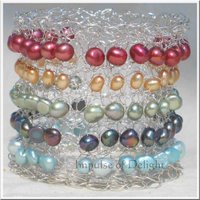 Who doesn't love pearls? From the demure luster of a strand of perfectly round white lovelies, to wildly shaped baroque pieces; from naturally occuring peach and lavender to wildly dyed colors, there are many many forms to delight the eye. Entire books have been written on the subject of pearls, but here are a few basic terms to get started with, taken from my own Materials Index.
Pearl: An organic gem grown within oysters and a few other mollusks. Formed when a foreign object, like a tiny stone, enters the mollusk's shell and the resulting irritation causes the oyster to form a secretion, called nacre, to cover it. As thousands of layers of nacre coat the irritant, a pearl is formed. Depending on the pearl's size, the process may take from four months to seven years.
Hardness: 2.5
Terms:
Cultured pearl - the irritant is implanted by humans and the mollusks are cultivated in a protected environment. Nearly all pearls available today are cultured.
Natural pearl - the irritant enters naturally, by chance. Extremely rare and valuable.
Freshwater pearl - mostly cultured in China - these are the pearls in my creations, unless otherwise specified. Occur in a range of natural colors, but are also commonly enhanced with radiation and/or dye. The brightest colors are likely dyed, and could fade over time. White varieties may be bleach enhanced.
Saltwater pearl - most famous are Oriental, Tahitian (aka South Sea) pearls. Perfect specimens are highly sought after.
Shell pearl - a shell bead with a ground pearl coating. Popular because they can be inexpensively created with perfect shape and color and are virtually identical in weight and appearance to cultured South Sea pearls. (They are not, however, gritty to the tooth and can also be distinguished by close inspection of the hole.) More durable than regular pearls - less affected by sweat and cosmetics.
Care: Pearls are among the world's softest gemstones and should be carefully cared for. Being composed largely of calcium carbonate, they readily dissolve in acids. They are sensitive to dryness and extreme humidity. Apply cosmetics, perfume or hairspray BEFORE putting on your pearls. Wipe them with a dry cloth after wearing, as human sweat and oils can dissolve and diminish their luster (however, regular wear is beneficial, due to the mild humidity from the skin.) Lengthy exposure to bright sunlight may yellow the color. Avoid jumbling them with harder stones that could scratch them. Clean with warm soapy water, (taking care not to get water in the drill hole) and dry on a soft towel. Not safe for ultrasonic cleaners.
Who doesn't love pearls? From the demure luster of a strand of perfectly round white lovelies, to wildly shaped baroque pieces; from naturally occuring peach and lavender to wildly dyed colors, there are many many forms to delight the eye. Entire books have been written on the subject of pearls, but here are a few basic terms to get started with, taken from my own Materials Index.
Pearl: An organic gem grown within oysters and a few other mollusks. Formed when a foreign object, like a tiny stone, enters the mollusk's shell and the resulting irritation causes the oyster to form a secretion, called nacre, to cover it. As thousands of layers of nacre coat the irritant, a pearl is formed. Depending on the pearl's size, the process may take from four months to seven years.
Hardness: 2.5
Terms:
Cultured pearl - the irritant is implanted by humans and the mollusks are cultivated in a protected environment. Nearly all pearls available today are cultured.
Natural pearl - the irritant enters naturally, by chance. Extremely rare and valuable.
Freshwater pearl - mostly cultured in China - these are the pearls in my creations, unless otherwise specified. Occur in a range of natural colors, but are also commonly enhanced with radiation and/or dye. The brightest colors are likely dyed, and could fade over time. White varieties may be bleach enhanced.
Saltwater pearl - most famous are Oriental, Tahitian (aka South Sea) pearls. Perfect specimens are highly sought after.
Shell pearl - a shell bead with a ground pearl coating. Popular because they can be inexpensively created with perfect shape and color and are virtually identical in weight and appearance to cultured South Sea pearls. (They are not, however, gritty to the tooth and can also be distinguished by close inspection of the hole.) More durable than regular pearls - less affected by sweat and cosmetics.
Care: Pearls are among the world's softest gemstones and should be carefully cared for. Being composed largely of calcium carbonate, they readily dissolve in acids. They are sensitive to dryness and extreme humidity. Apply cosmetics, perfume or hairspray BEFORE putting on your pearls. Wipe them with a dry cloth after wearing, as human sweat and oils can dissolve and diminish their luster (however, regular wear is beneficial, due to the mild humidity from the skin.) Lengthy exposure to bright sunlight may yellow the color. Avoid jumbling them with harder stones that could scratch them. Clean with warm soapy water, (taking care not to get water in the drill hole) and dry on a soft towel. Not safe for ultrasonic cleaners.
Sunday, February 19, 2006
Pearls
Posted by
Ruth
at
2/19/2006 08:32:00 AM
![]()
Subscribe to:
Post Comments (Atom)

No comments:
Post a Comment